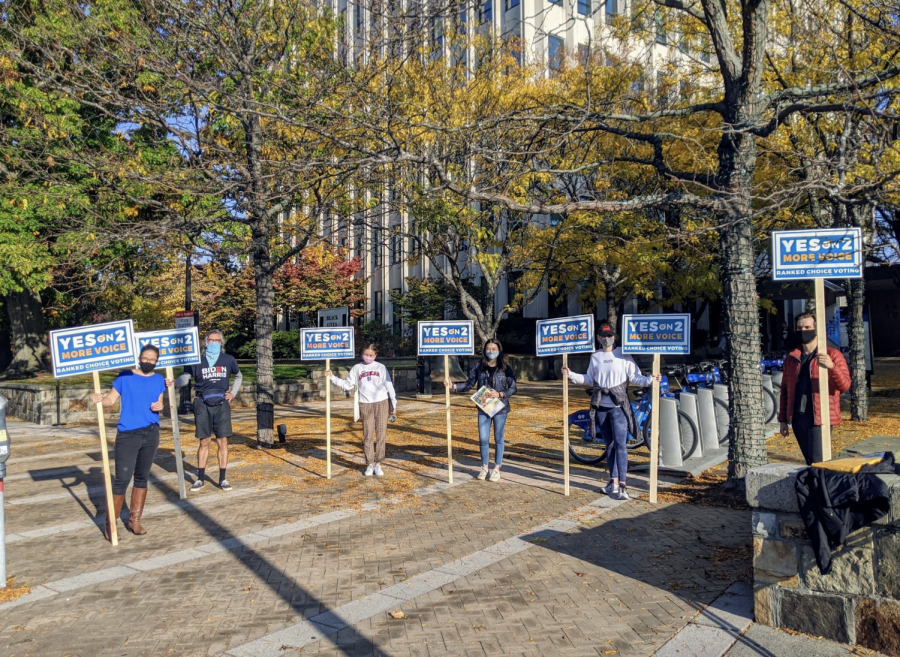Massachusetts prepares to vote on Ranked Choice Voting
Protestors gather and rally support for the implementation of Rank Choice Voting.
October 28, 2020
On Nov. 3, Massachusetts voters will choose whether to implement ranked choice voting or uphold the status quo of winner-take-all.
The majority of elections in the United States use the “winner-take-all” system, where you choose your candidate for each race, grab your “I voted sticker” and head out. But with ranked choice voting, commonly referred to as RCV, voters ranked candidates as their first choice, second choice, third choice and so on. Voters can choose to rank edonly some of the candidates or even just one. The candidate who wins the majority of the votes (in this case, “majority” means greater than 50 percent) wins the election. If no candidate wins a majority of first-choice votes, the candidate with the least number of votes is eliminated, and their votes are redistributed. This process repeats until someone wins a majority of the votes.
While RCV may sound outlandish, it is used throughout the country. Cambridge elects its city council and school committee using a multi-winner variant of RCV. Maine uses RCV for local, statewide and federal elections. Currently, cities in California, Maryland, Minnesota and New Mexico use RCV for local elections. Last year, New York City voted to implement RCV for its city council, citywide and borough president primaries in 2021. This November, ranked choice voting is on the ballot in Alaska, and Mainers will vote for the president using RCV — the first time RCV will be used for a presidential race in the United States.
Most voters have never used, let alone heard of, RCV. Some opponents of ranked choice voting worry that an alteration to our voting system would be too confusing for voters, but studies show that is not the case.
“Once people actually vote in their first ranked choice election, their positive evaluations of the system increase,” said Victoria Shineman, University of Pittsburgh political science assistant professor. “People liked the system even more after they’d used it.”
In her research on mobilizing voters in San Francisco, she found that people who have voted in at least one election that uses RCV found that ranked choice voting was easy to understand and was better than the plurality system. Additionally, voters are more confident not only in their abilities to ranked the candidates but in their capabilities as voters.
“[RCV] is the kind of thing voters want to tell their friends about,” said Evan Falchuk, board chair of the Yes On 2 campaign and former candidate for governor of Massachusetts.
Over the past couple years, thousands of volunteers across Massachusetts worked to collect over 100,000 signatures to get RCV on the ballot, focusing on electronic signatures during the COVID-19 pandemic. Supporters of RCV in Massachusetts include U.S. Senators Elizabeth Warren and Edward Markey, U.S. Representatives from districts 2-7, Attorney General Maura Healey, Secretary of the Commonwealth William F. Gavin and dozens of state senators and representatives.
Both the Massachusetts Democratic Party and Libertarian Party support RCV along with groups such as the Sierra Club, Boston Teachers Union, Amplify Latinx and Fair Vote.
“There’s a thirst for change,” said Rev. Vernon K. Walker, executive committee member and political committee member of the Sierra Club Massachusetts Chapter.
Still, some organizations are against the idea; Americans for Tax Reform, Massachusetts Fiscal Alliance and Protect My Ballot all oppose Question 2. According to a poll by MassINC Polling Group for WBUR, 36 percent of the registered voters who were polled support RCV, and 36 percent reject RCV. The remaining 28 percent were undecided.
“The biggest hurdle is voters sitting down and learning about RCV,” Walker said. “It’s about education. It’s about educating people about what RCV is and once people are educated about what it is, I think they will vote for it.”
With RCV, since voters aren’t required to rank every candidate, they don’t have to involuntarily choose any candidate they dislike.
“Ranked choice voting can help revolutionize the way in which our democracy operates,” Walker said. “You can vote for the person you like the least without fear of electing the candidate you like the least. It prevents voters from having to pick between the lesser of two evils.”
Supporters of RCV also point to how it changes the ways in which candidates campaign.
“The current system makes it easy to spend your time trying to divide us instead of uniting us,” said Falchuk.
Negative campaigning, or purposefully smearing the reputation of an opponent, has a long history in the United States with modern examples of negative campaigning including Hillary Clinton airing television ads aimed at highlighting the difference in experience levels between her and Barack Obama, and Rep. Joe Kennedy’s ad accusing Sen. Ed Markey of betraying Malden workers.
“RCV encourages more collaborative campaigning. Instead of trying to say horrible things about you which might make your supporters hate me, it made people more likely to recognize the strengths of their opponents,” Shineman said. “Because they wanted to be voters’ second choices too.”
Opponents of RCV argue that RCV is too complex and difficult for voters to understand. When asked to rank multiple candidates, it’s “hard to believe” that a voter could differentiate enough between the various candidates.
“In our ideal world voters are informed and opinionated. Uninformed voters are just something that democracy deals with, and the way democracy deals with that is by asking lots and lots of people,” said Rory Smead, assistant professor of philosophy and the Rossetti Professor for the Humanities at Northeastern University. “It all depends on what we want out of democracy. More complicated isn’t always a bad thing, especially when it allows us to better express our voices.”







